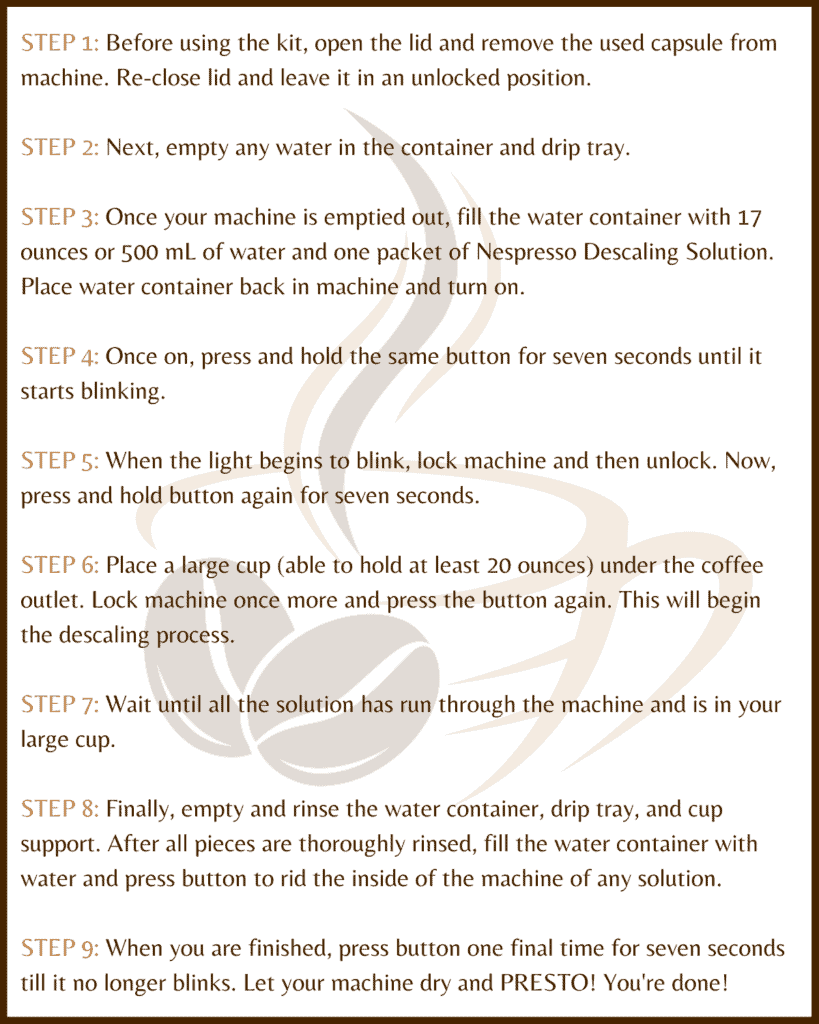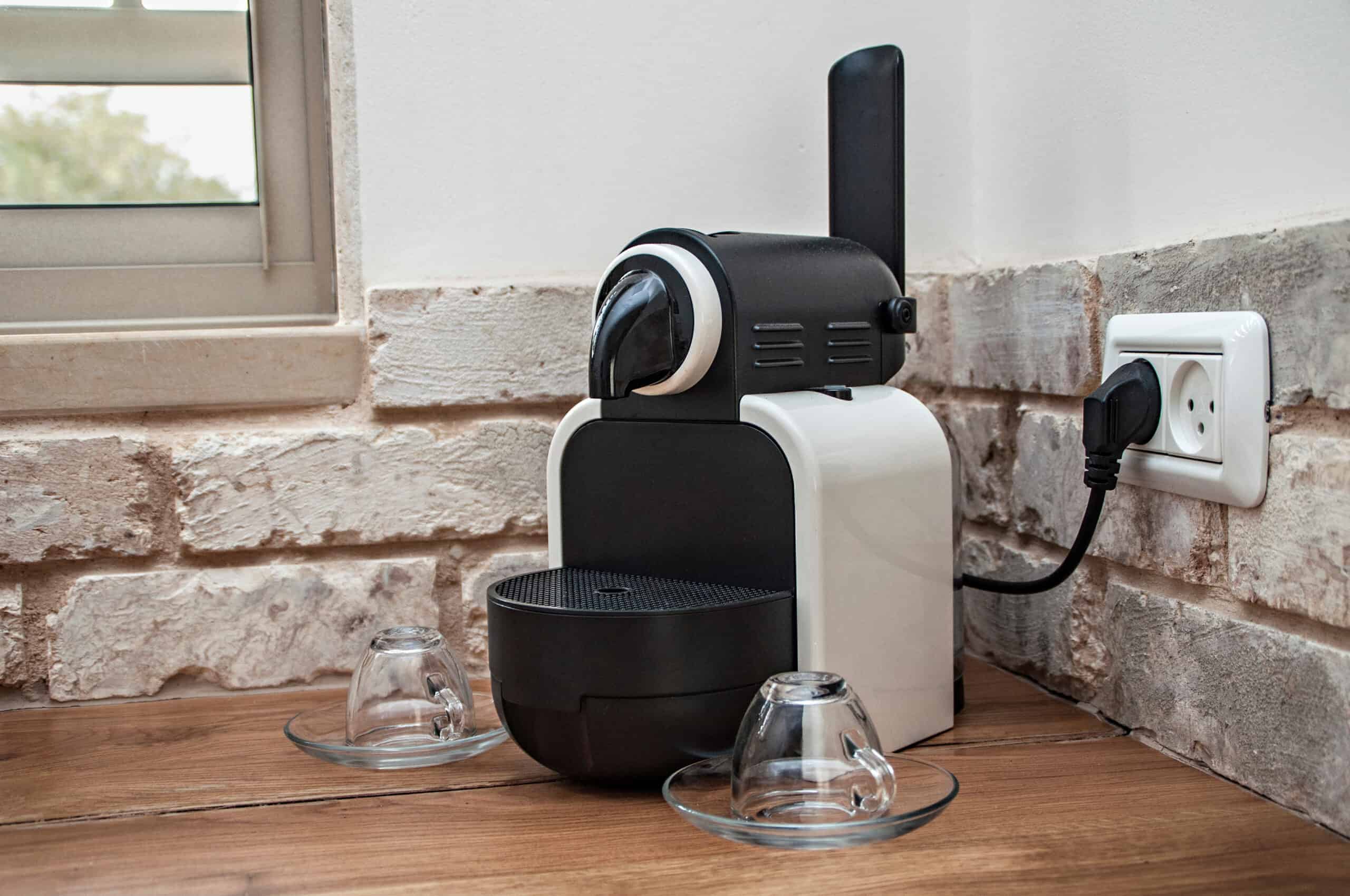You brew coffee in your Nespresso almost every morning. Today started like any other day until you discovered your coffee machine was leaking. After quickly cleaning up the mess, you’re eager to prevent this from happening again. How do you fix your Nespresso?
There are a handful of causes for your Nespresso Machine to be leaking, with the most likely culprit being that it has a built-up of limescale. The solution is to descale your machine. If that doesn’t solve the problem, you can check some other things, including the capsule holder and machine base.
If your Nespresso is only a few weeks old and you are dealing with it leaking, there is probably something wrong with the machine. Because the items we’re going to cover today deal with normal wear and tear of the device and how to keep it clean, I would suggest contacting customer service first if the leaking occurs shortly after purchasing.
If your Nespresso is a bit older, you’ve come to the right place. First, let’s delve into why descaling is necessary and how often it should be done.
Then we’ll look at some other scenarios for why your Nespresso may be leaking along with solutions. Hopefully, we can get your Nespresso machine up and running again so you can enjoy that freshly brewed cup of coffee.
Descaling Your Nespresso Machine
Along with other coffee makers, Nespresso machines start to build up hard deposits of calcium and lime from the water you use. When it is not regularly cleaned or descaled, this can cause clogging and blockages, leading to your machine leaking.
Not only will it cause the Nespresso to stop working correctly, but it will also give your coffee a bitter taste, prolong the brewing process, sound louder, and affect the temperature of your cup of coffee.
How often should you descale? Descaling your Nespresso every three to six months is best, depending on how often it is being used and the water’s quality. If your water is hard (having a lot of minerals in it), then descaling should be done closer to the three-month mark.
There are Nespresso Descaling Kits you can purchase here that are specifically designed for your machine, or you can also use any of the options presented below. I do recommend using the one specifically designed for the Nespresso. If other descaling solutions ruin your machine for some reason, the warranty will likely be void.
The descaling process is relatively simple and only takes about twenty minutes. Follow these nine easy steps to get your Nespresso clean and operating properly.

Blockage in the Capsule Holder
If you completed the descaling process and still are experiencing leaking with your Nespresso machine, the problem may lie with the capsule holder having a blockage. This blockage occurs when old coffee grinds and other residue builds up on the nozzle.
This is most likely the culprit if water is leaking from the capsule holder or drip tray when the Nespresso is in use.
Just as you should regularly descale your machine, making sure you remove the capsule immediately after use and cleaning the capsule holder often are essential. This will ensure your Nespresso is always running properly and preventing any blockages from forming.
If regular cleaning is not occurring, residue builds up and can clog the machine leading to unwanted leaking. To clean, you can use a cloth or a small stiff brush along with warm soapy water. Gently scrub the capsule holder until all coffee residue is gone.
If you are still experiencing leaking and the capsule holder looks clean, try to see if there is any hidden residue inside of the nozzle. When the nozzle is clogged, the water pressure going through the capsule is affected. You may have to carefully use a needle to clear any clogs in it. (NOTE: Can damage the machine if not done gently, contact Nespresso for further instructions.)
Once clean, rinse all the soap off so the next cup of coffee you make doesn’t get any leftover soap residue in it.
Using Incorrect Capsules
Another simple issue that could lead to a leaking Nespresso machine is using incorrect capsules. Sometimes when using off-brand coffee pods, they may not be the exact size that your Nespresso takes. Try to use the typical Nespresso pods to determine if incorrect capsules are the culprit.
Broken Water Tank Valve Seal
A broken water tank valve seal is another possibility. The valve seal is a small rubber seal meant to prevent water from leaking from the Nespresso when not being used. If this is the case, then water will be leaking from underneath the machine.
To determine if this is the cause, remove the water tank and dump any water in it. Turn it upside down and visually see if there are any cracks where water could be seeping out. If you see noticeable damage, purchasing a new water tank is really your only option.
If no cracks are visible, fill the water tank with water and place it on a dry paper towel or napkin. If you see that the paper towel is wet after a while, you know there is, in fact, the seal is broken, and you need to purchase a replacement.
Other Issues Causing the Leaking
The problems and solutions discussed above are some of your Nespresso’s more likely and more fixable issues. Of course, there are other working parts to your machine that could be the cause of the leaking. Unfortunately, those issues are a little more complicated and would require more intense investigating and repairs that are above the average person’s skills.
Contact the company’s customer support to inform them of the issue. They may have some further tips for you to try or possibly send you a new one if it’s a complaint they have been receiving with a particular model.
I’ve found that the company is actually very helpful, especially if it is within the two year warranty. It is not uncommon for them to remedy the problem either by asking you to send it in to them to repair or by issuing you a replacement. Click here for the link to Nespresso Warranty Page.
If your leaking Nespresso maker is over three to five years old, it may be time to invest in a new machine. This is typically how long you can expect your Nespresso to last.
Additional Concerns About Your Nespresso
Why is there water in the drip tray?
It is actually normal for there to be some water in the drip tray; that is why it is there. To prevent overflow, dump the water after about five cups of coffee.
Why is my coffee only lukewarm?
Check to make sure the light is not flashing. If it is, the machine is still in descaling mode, and you need to press the Espresso and Lungo buttons at the same time for three seconds.
If the environment is extremely cold, warming up your cup first before brewing your coffee with the Nespresso will help the coffee stay warmer for longer.
Why is there no water/coffee coming out of the device?
First, ensure the water tank is full and in its appropriate position. Sometimes, it doesn’t entirely fall into the right place. If that isn’t the cause, you may have to reset it.
With the machine on, lift the lever and press the Lungo button to finish the brewing cycle. Empty the water from the cup, lower the lever, and press the Lungo button once more. At this point, if you do not hear the pump working, notify Nespresso through their customer service.
Final Thoughts
Unfortunately, our favorite coffee machines never lasts forever. Hopefully, you can solve the issue using the advice and tips provided. If not, it may be time to treat yourself to the latest models of your favorite Nespresso Machines. Good luck and enjoy!
